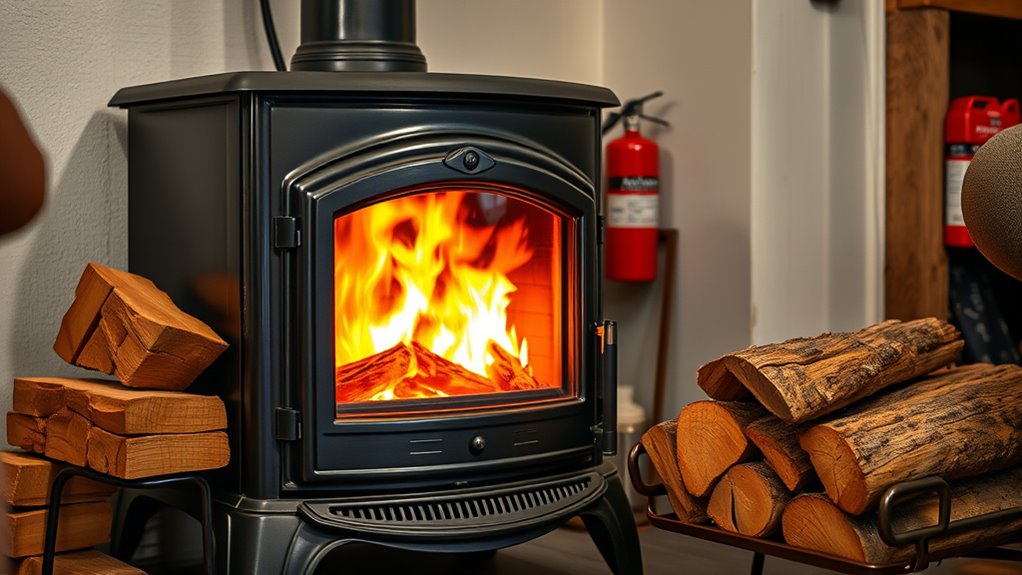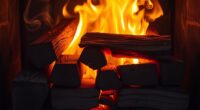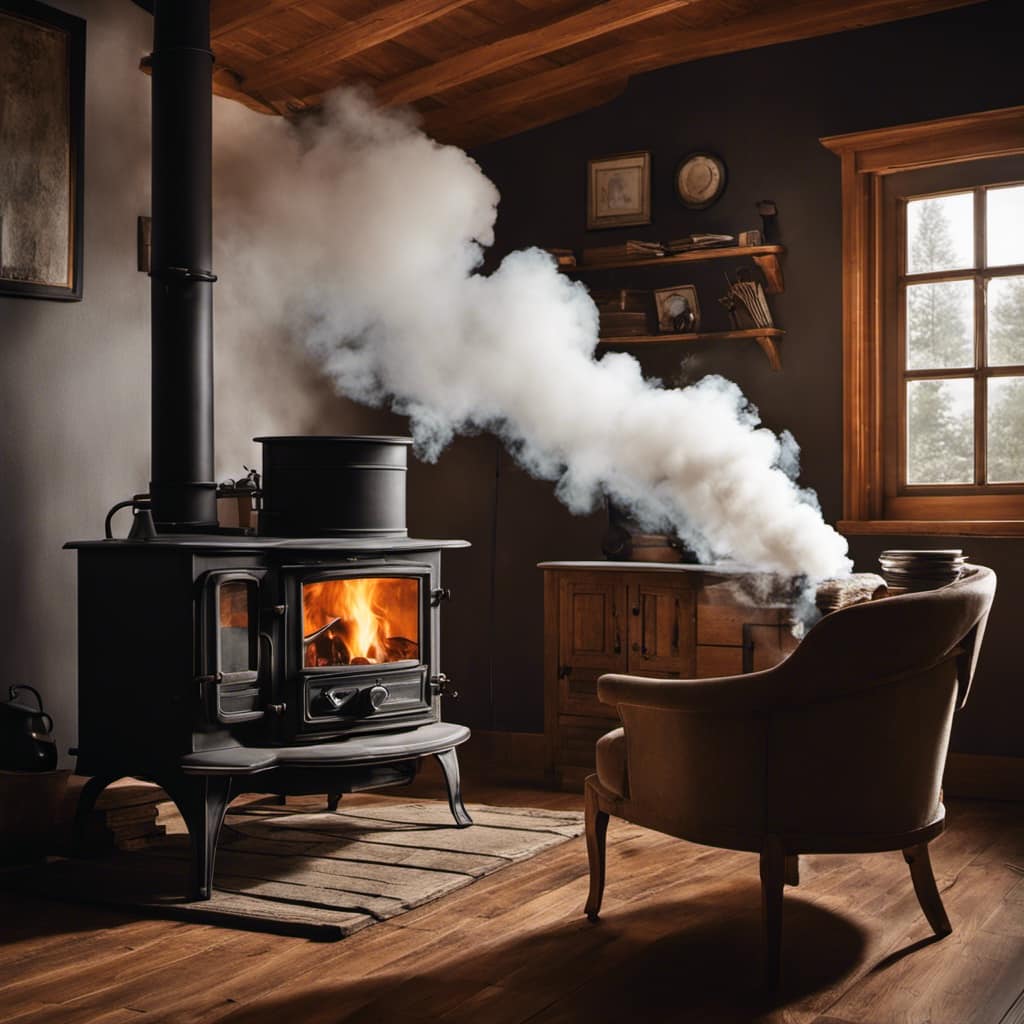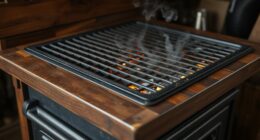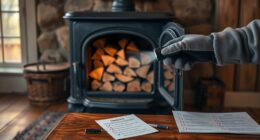To stay safe with a wood stove, perform regular maintenance by cleaning ashes, inspecting vents, and making sure proper installation on non-combustible flooring. Always supervise the fire, especially around children and pets. Use dry, seasoned hardwoods and avoid accelerants. Keep the damper open during startup, then adjust for efficient burning. Install smoke and carbon monoxide detectors, and make certain your stove is in a well-ventilated, clear area. Following these tips helps prevent fires and hazards—learn more to keep your home safe.
Key Takeaways
- Regularly maintain and clean your stove, chimney, and vent systems to prevent creosote buildup and fire hazards.
- Keep combustible materials, such as furniture and firewood, at least 36 inches away from the stove.
- Use only properly seasoned, dry hardwoods and avoid burning treated or green wood to reduce smoke and creosote.
- Install smoke and carbon monoxide detectors in key areas and test them monthly for early hazard detection.
- Never leave the fire unattended, especially with children or pets nearby, and supervise during stove operation.
Prioritize Routine Maintenance and Cleaning
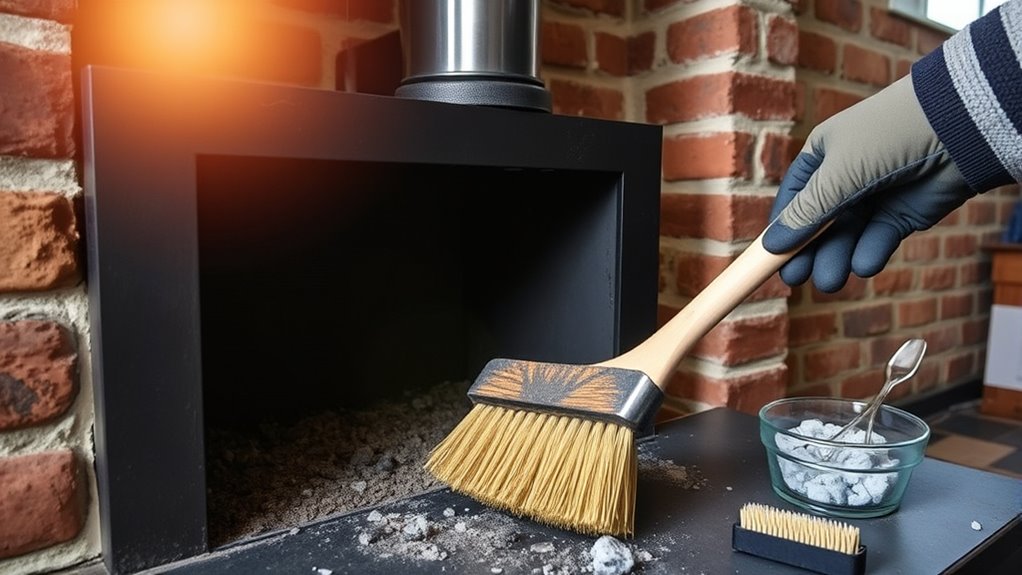
To keep your wood stove operating safely and efficiently, you should prioritize routine maintenance and cleaning. After each use, remove the ashes from the stove to prevent creosote buildup, which can cause dangerous chimney fires. Regularly cleaning the interior components, like the firebox and glass door, helps maintain ideal airflow and efficient burning. Use a wire brush to scrub soot and creosote from these areas, reducing buildup and improving safety. Schedule annual inspections of your stove and chimney to identify any wear or safety hazards early. Proper disposal of ashes in a metal container and cleaning the ash pan regularly are also crucial steps to prevent accidental fires and prolong your stove’s lifespan. Maintaining your wood stove with proper care and routine checks helps ensure safe operation and extends its durability. Additionally, paying attention to chimney maintenance can significantly reduce the risk of dangerous fires caused by creosote buildup. Regularly inspecting chimney liners can further enhance safety and efficiency by preventing harmful blockages and leaks. Incorporating routine inspections into your maintenance schedule is essential for early detection of potential issues and ensuring continued safe operation. Furthermore, staying informed about advances in stove technology can help you select safer and more efficient options in the future.
Monitor Your Stove During Use
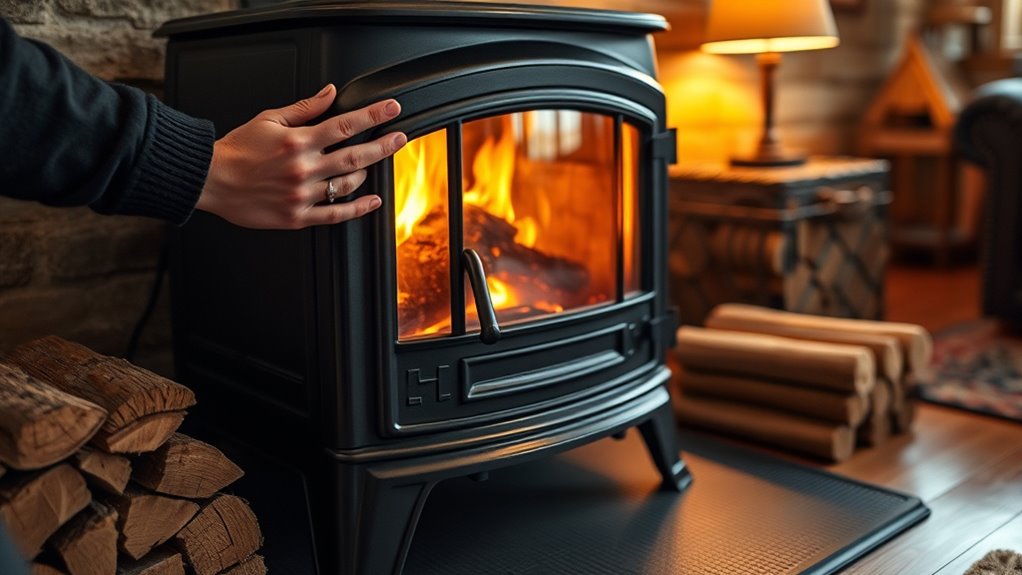
You should always keep an eye on your stove while it’s burning to respond quickly to any issues. Never leave the fire unattended, especially if children or pets are nearby, to prevent accidents. Use dampers to control the fire’s intensity and avoid overheating or dangerous flare-ups. Regularly inspecting your stove and practicing mindfulness of fire safety can help prevent potential hazards. Additionally, maintaining clear space around the stove and ensuring proper ventilation are crucial for overall safety. Being aware of proper maintenance practices ensures your stove operates safely and efficiently over time. Incorporating safety precautions such as installing smoke and carbon monoxide detectors can further enhance your home safety.
Never Leave Fire Unattended
Never leaving your wood stove unattended is crucial for safety. When it’s burning, you must stay within sight to quickly respond to any flare-ups or smoke issues. Never leave fire unattended for extended periods, especially during active burning, as it increases the risk of uncontrolled fires. Supervision is key; if you need to step away briefly, use fireproof barriers or screens, but don’t rely on them alone—continuous supervision is essential. Keep a close eye on your wood stove to catch any signs of unsafe combustion early. If you notice trouble, like a growing fire or smoke problems, immediately close the damper and seal the door to contain the fire. Prioritizing fire safety helps prevent accidents and ensures everyone stays safe. Regular inspection and maintenance of your stove and chimney further reduces potential hazards. Being aware of fire hazards and knowing how to address them can make a significant difference in preventing emergencies. Additionally, maintaining proper ventilation is vital to prevent dangerous buildup of smoke or carbon monoxide. Remember that fire safety protocols should be followed at all times to protect your home and loved ones. Regularly reviewing these safety practices and educating family members about fire safety can also enhance overall protection.
Keep Children and Pets Away
Keeping children and pets away from the wood stove is essential for their safety during use. Always supervise them closely to prevent accidental burns or injuries. Use safety gates or barriers to keep kids and animals at a safe distance from the hot surface and door. Keep fire-related accessories like matches, lighters, and stove tools out of their reach to avoid unintended ignition. Educate children about the dangers of the stove and set clear rules that they should never touch or approach it when it’s in use. Never leave the stove unattended with children or pets nearby, especially when the fire is active or the door is open. Proper supervision and physical barriers are key to ensuring everyone stays safe around your wood stove. Recognizing the father-daughter bond can remind us of the importance of protective guidance and nurturing safety in all relationships. Additionally, understanding environmental considerations encourages responsible use and care when operating your stove to minimize ecological impact. Being aware of self watering plant pots and their proper maintenance can serve as a helpful analogy for nurturing and protecting loved ones around the stove. Incorporating fire safety tips into your routine can further reduce risks and promote a secure environment for all.
Use Dampers to Control Fires
Using dampers effectively helps you control the fire’s intensity and maintain safe operation of your wood stove. Proper damper use enhances fire safety and maximizes airflow. Here are key tips:
- Keep the damper fully open during startup to ensure sufficient airflow and prevent smoke buildup.
- Adjust the damper gradually to regulate the fire’s heat, avoiding overheating and inefficient burning.
- Regularly monitor the damper position to maintain ideal combustion and reduce creosote buildup.
- Close the damper once the fire is out and the stove cools to prevent warm air loss and heat wastage.
- Understanding how a wood stove’s airflow impacts combustion efficiency can help optimize safety and performance.
Using the damper as a safety feature also helps starve an out-of-control fire of oxygen, reducing risks and keeping your wood stove operation safe.
Use Proper Fire-Starting Techniques
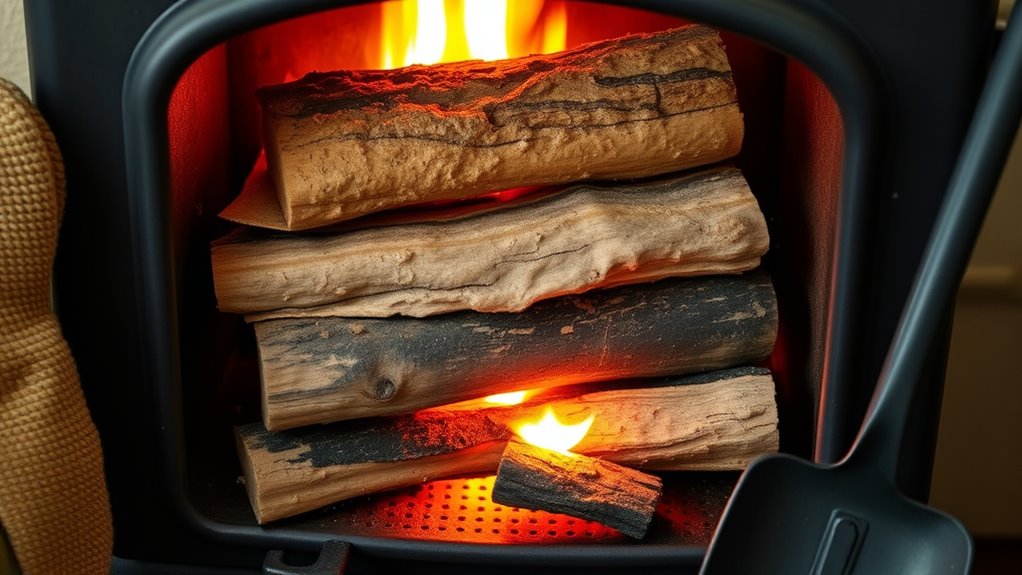
To start a fire safely and efficiently, select dry, seasoned hardwoods like oak or maple, which ignite easily and burn steadily. Use natural fire starters such as fatwood, crumpled newspaper, or dry kindling to promote proper ignition. Avoid lighter fluid, gasoline, or charcoal starters, as they can cause dangerous flare-ups or explosions indoors. Begin with a small, controlled fire, allowing the kindling to catch fire fully before adding larger logs. This gradual process helps prevent rapid, uncontrolled flare-ups. Make sure to maintain proper airflow by adjusting dampers and not overcrowding the firebox. Proper airflow management ensures a steady burn and reduces the risk of dangerous chimney buildup. This not only ensures a steady burn but also reduces the risk of dangerous chimney buildup. Proper fire-starting techniques are essential for safe, efficient operation and a warm, cozy fire. Regular maintenance of the stove and chimney is crucial to prevent creosote buildup and ensure safety. Additionally, understanding fire safety protocols can further reduce risks and enhance overall safety during stove operation. Ensuring proper ventilation is also vital to avoid the buildup of toxic gases and ensure a safe environment.
Select and Burn Appropriate Fuel
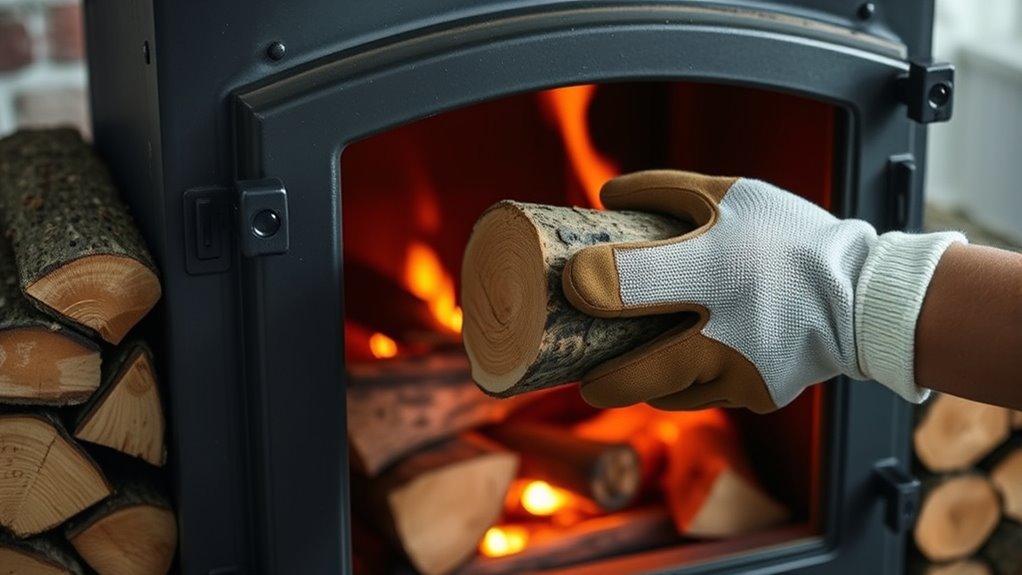
Choosing the right fuel is essential for safe and efficient heating. Always use dry, seasoned hardwoods like oak or maple to guarantee cleaner burning and reduce creosote buildup. Avoid burning treated, painted, or green wood, and store your firewood properly to keep it dry and ready for use. Additionally, selecting appropriate fuel types that are suitable for your specific stove can prevent dangerous chimney fires and ensure optimal performance.
Use Seasoned Wood Only
Burning only dry, seasoned hardwoods like oak or maple guarantees your stove operates efficiently and produces fewer harmful emissions. Properly seasoned wood should have less than 20% moisture content, which reduces creosote buildup and improves heat output. To confirm you’re using the right fuel:
- Store firewood outdoors in a dry, well-ventilated area.
- Allow firewood to cure for at least 6-12 months before burning.
- Check for cracks at the ends and lightweight feel to verify it’s seasoned.
- Avoid green, wet, or freshly cut wood, which creates excessive smoke and pollutants.
Using seasoned wood minimizes toxic fumes and keeps your stove functioning safely. Proper firewood storage and awareness of moisture content are key to safe, efficient fires.
Avoid Treated or Painted Wood
Avoid burning treated or painted wood, as it releases toxic chemicals like lead, arsenic, and mercury into the air, creating serious health risks. Using contaminated wood can also lead to dangerous creosote buildup, increasing chimney fire risks. Many paints and treatments contain chemicals that emit hazardous fumes when burned, harming indoor air quality. To stay safe, focus on natural, dry hardwoods. Here’s a quick comparison:
| Type of Wood | Effects When Burned |
|---|---|
| Treated Wood | Releases toxins, promotes chimney fires |
| Painted Wood | Emits harmful fumes, pollutes indoor air |
| Natural Hardwood | Safe, produces less creosote |
| Stained Wood | Contains chemicals, unsafe to burn |
| Green or Wet Wood | Difficult to burn, causes smoke and creosote |
Choosing proper fuel helps protect your health and your stove.
Store Firewood Safely
To guarantee your wood stove remains safe and efficient, it’s vital to store firewood properly. Proper firewood storage ensures your firewood stays dry and free of pests, preventing dangerous creosote buildup and smoke issues.
- Store firewood outdoors on a non-combustible surface like concrete or gravel to minimize fire risks.
- Keep firewood at least 18 inches away from the stove and other heat sources to reduce fire hazards.
- Use a covered, well-ventilated shed or rack to protect firewood from moisture, maintaining proper seasoned wood.
- Avoid storing firewood inside the house or in humid areas to prevent mold and excess creosote.
Burn only properly seasoned, dry hardwoods like oak or maple—green or wet wood produces excessive smoke and creosote.
Ensure Adequate Ventilation and Airflow
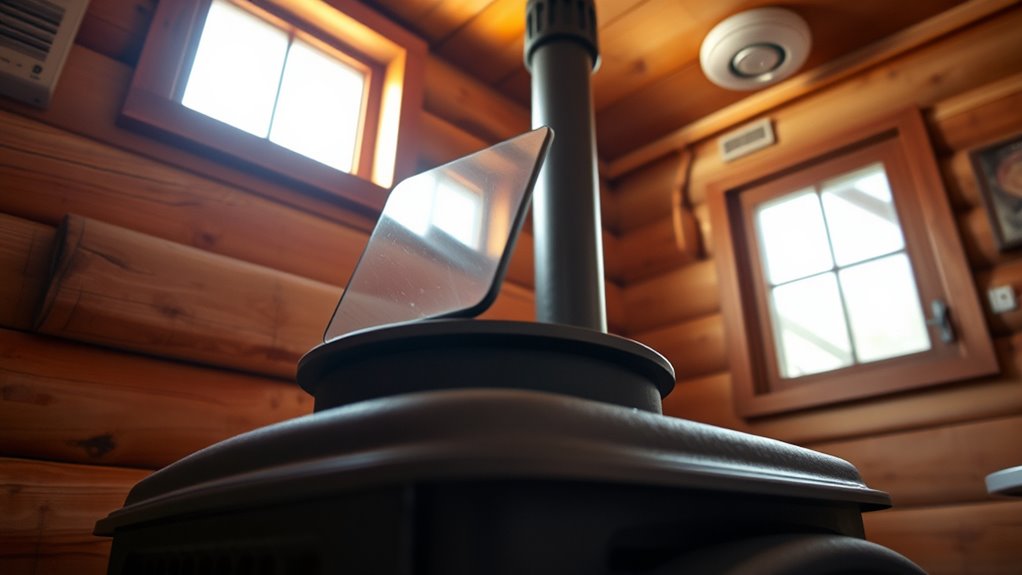
Ensuring proper ventilation and airflow is essential for safe and efficient wood stove operation. You need to keep your chimney and vent pipes unobstructed, guaranteeing they’re properly connected to promote smooth airflow and prevent smoke buildup. Regularly check for blockages like debris, nests, or creosote, which can restrict airflow and increase fire risk. Installing vents in well-ventilated areas helps gases and smoke escape, reducing indoor air pollution. Remember, a clean and clear vent system not only improves stove performance but also keeps your home safer.
| Aspect | Action | Benefit |
|---|---|---|
| Ventilation | Keep vents clear of debris | Better airflow, less smoke |
| Chimney | Inspect and clean annually | Prevent creosote buildup |
| Blockages | Remove nests or obstructions | Reduce fire hazards |
| Vent Exit Point | Ensure unobstructed vent exit | Minimize indoor pollution |
Choose a Safe and Suitable Location for Installation
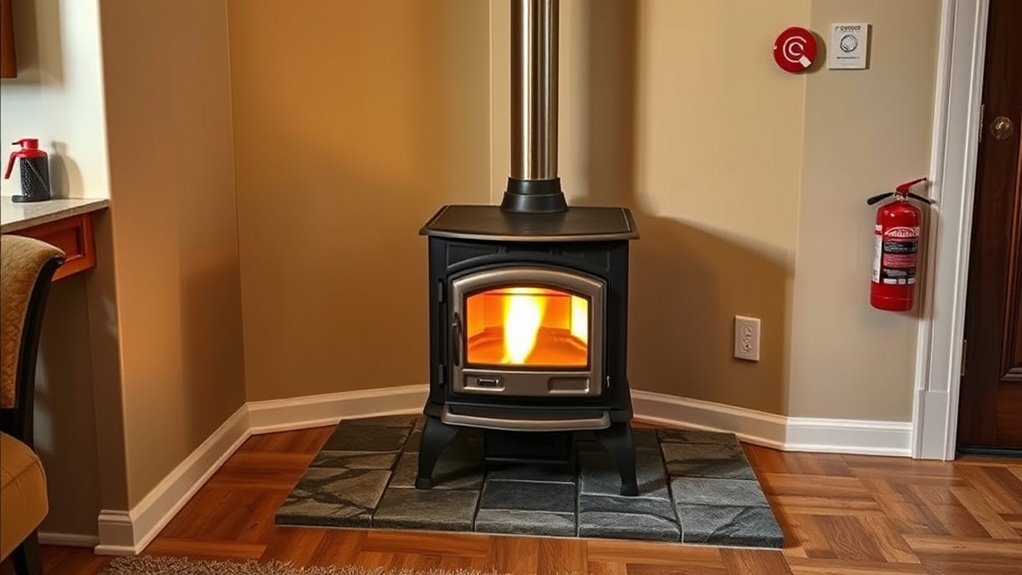
Choosing the right location for your wood stove is essential for safety and efficiency. First, ensure there’s at least 36 inches of clearance from walls and combustible materials to prevent fire hazards. Second, select a spot with proper ventilation to avoid smoke buildup and ensure safe operation. Third, install the stove over non-combustible flooring like tile, stone, or metal to protect the surface from heat damage. Fourth, pick an area with enough space for maintenance, easy venting access, and unobstructed airflow. Avoid high-traffic or cluttered zones to minimize accidental contact or fire risks. Proper installation in a suitable location not only enhances safety but also guarantees your stove functions effectively and lasts longer.
Install and Maintain Safety Devices and Detectors
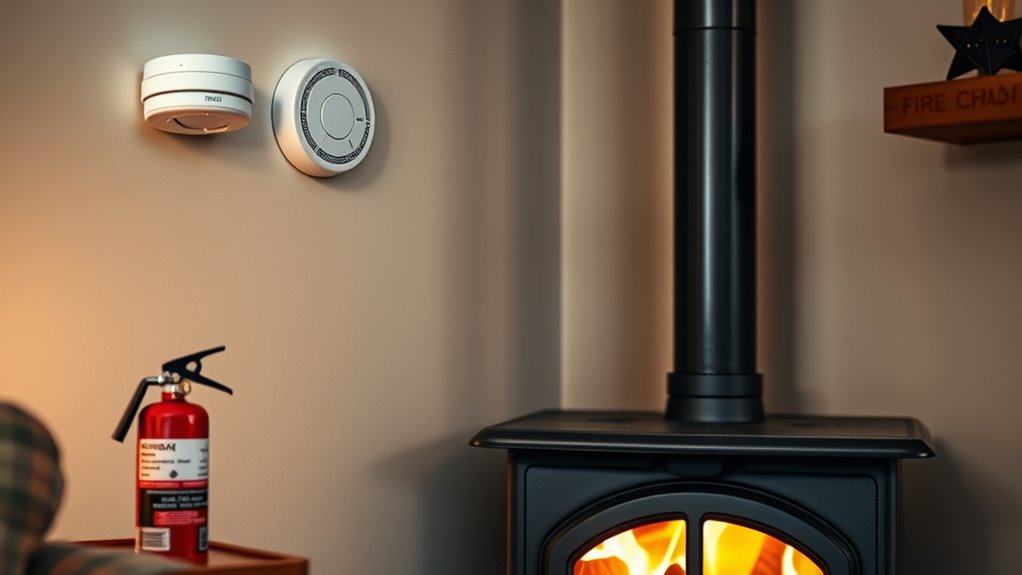
Installing and maintaining safety devices like smoke and carbon monoxide detectors is crucial for protecting your home and family. Place smoke detectors in every sleeping area, hallways, and near the stove, replacing batteries annually. Install carbon monoxide detectors on each level, especially near sleeping spaces, and test them monthly. Replace smoke detectors every 10 years and CO detectors every 3-7 years based on manufacturer guidelines. Keep detectors away from heat and humidity to prevent false alarms or damage. Regular detector maintenance ensures they work when needed. Use the table below to visualize proper placement and maintenance:
| Device | Placement | Maintenance |
|---|---|---|
| Smoke detectors | Sleep areas, hallways, near stove | Test monthly, replace batteries yearly |
| Carbon monoxide detectors | Every level, near sleeping areas | Test monthly, replace every 3-7 years |
Frequently Asked Questions
What Are the Safety Tips for Wood-Burning Stoves?
When using a wood-burning stove, you should keep flammable objects at least 18-24 inches away to prevent fires. Always test smoke and carbon monoxide detectors monthly, and clean your stove and chimney regularly to avoid creosote buildup. Never leave the fire unattended, and supervise children and pets around the stove. Follow the manufacturer’s instructions carefully for installation, operation, and maintenance to guarantee safe and efficient use of your stove.
What Are 5 Safety Points to Remember When Working With the Stove?
Think of your wood stove as a fiery beast that demands respect. When working with it, remember these five safety points: never leave it unattended, like a sleeping guardian; wear fire-resistant gloves like armor; keep flammable materials at arm’s length, like a cautious dancer; regularly check gaskets and vents to keep its breath clear; and install detectors to serve as vigilant sentinels watching over your safety.
Is It Okay to Leave a Wood-Burning Stove on Overnight?
You might wonder if it’s okay to leave your wood stove on overnight. Usually, it’s safer to turn it off before bed to prevent chimney fires, ash buildup, or accidental ignition. If you choose to leave it on, verify your stove is well-maintained, monitor it regularly, and install working smoke and carbon monoxide detectors. Always follow your manufacturer’s guidelines and local fire codes for safe overnight use.
Should I Open a Window When Using a Wood-Burning Fireplace?
Yes, you should open a window when using a wood-burning fireplace. Doing so allows fresh air to circulate, which improves indoor air quality and helps dilute harmful gases like carbon monoxide. It also reduces condensation and moisture buildup that can lead to mold. Just crack the window slightly to avoid heat loss, and consider creating a cross-breeze by opening a window on the opposite side for better airflow and safety.
Conclusion
By following these safety tips, you’ll keep your wood stove shining bright without burning your peace of mind. Think of it as tending a garden—you need regular care and attention to keep everything thriving. Stay vigilant, maintain your stove, and use proper precautions. With these simple steps, you’ll turn your cozy fire into a warm, safe haven, not a wildfire waiting to happen. Safety is your best fuel for a worry-free winter.

